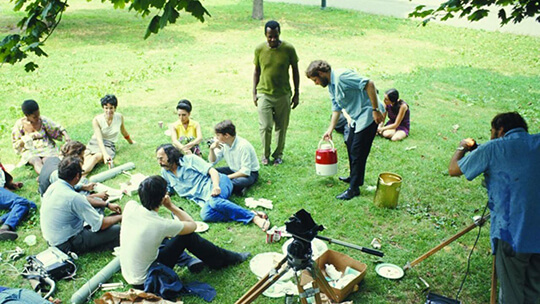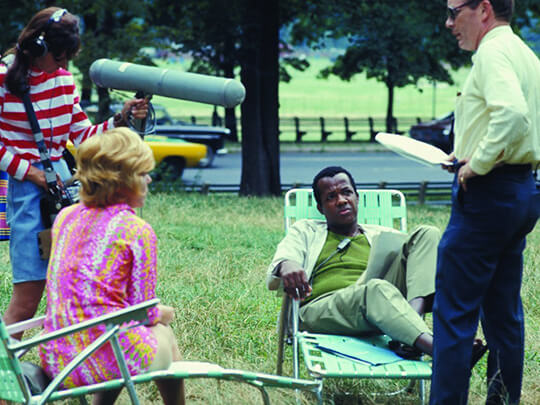
WHAT’S IT ABOUT
Symbiopsychotaxiplasm: Take One is a groundbreaking experimental film directed by William Greaves that defies conventional categorization. Shot in 1968 in New York’s Central Park, the film is a complex, multi-layered exploration of the filmmaking process itself, blending documentary, fiction, and meta-commentary in ways that were decades ahead of its time. On its surface, the film follows a director (Greaves himself) as he attempts to film a dramatic scene between a quarreling couple on a park bench. However, this is merely the entry point to a much more intricate experiment. Greaves simultaneously documents:
- The actors performing the scene
- The film crew filming the actors
- A second film crew documenting the first crew and their increasing frustration
- The crew’s behind-the-scenes discussions about Greaves’ seemingly incompetent direction
As the production continues, the crew becomes increasingly confused and rebellious, eventually holding meetings to discuss whether the project is worthwhile or if Greaves knows what he’s doing. Unbeknownst to them, these rebellious discussions are precisely what Greaves is interested in capturing—the “symbiopsychotaxiplasm” or the web of interpersonal dynamics and power structures that emerge when people work together. The film brilliantly questions directorial authority, the nature of reality versus performance, and the power dynamics inherent in filmmaking, all through a distinctly Black perspective that was revolutionary for its time.



WHY IT’S GONE
The film’s experimental nature and its director’s identity as an African American filmmaker in the 1960s made traditional distribution nearly impossible. It was too unconventional for mainstream theaters and too ambitious to be categorized as merely an “independent” or “Black” film. The film fell into the gap of works that weren’t properly preserved by major film institutions, which historically prioritized more conventional cinema or works by established white filmmakers. The film’s meta-commentary on filmmaking and its deconstruction of authority predated similar work by white directors like Robert Altman that would later be celebrated. This innovative approach made it difficult for audiences and critics of the era to properly contextualize. Greaves self-financed much of the project, limiting his ability to promote or distribute it widely. The film remained largely unseen until it was rediscovered in the 1990s by filmmakers Steve Buscemi and Steven Soderbergh, who championed its restoration. The film received its first proper public showing at the Sundance Film Festival in 1992, nearly 25 years after it was made. In 2006, Criterion released a DVD edition (spine #360) that paired it with its 2005 sequel, Symbiopsychotaxiplasm: Take 2½. This marked the first time the film became widely available for home viewing. The film has extremely limited streaming presence. It occasionally appears on the Criterion Channel during special programming blocks but is otherwise absent from major streaming platforms, including Netflix, Amazon Prime, Hulu, and HBO Max. As of 2025, the Criterion DVD remains the primary legal way to view the film, though it’s frequently out of stock or available only through secondary markets at premium prices. The continued scarcity of Symbiopsychotaxiplasm: Take One speaks to ongoing issues with how experimental works by Black filmmakers are preserved, distributed, and made accessible to audiences. Despite its influence on generations of filmmakers and its status as a landmark of American independent cinema, it remains difficult for most viewers to experience this revolutionary work.

